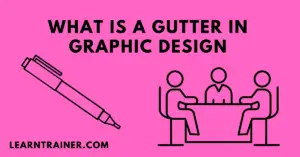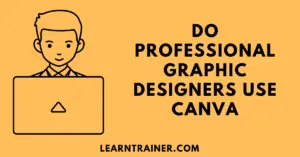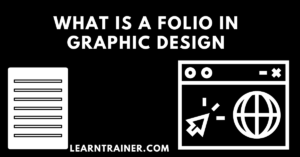Do You Need To Be Good At Drawing to Be a Graphic Designer?
Today, we will be discussing a topic that often sparks debate among aspiring graphic designers – do you need to be good at drawing to be a successful graphic designer? This question has been a source of confusion for many, and I am here to provide some clarity on the matter.
Do you need to be a skilled artist to be a graphic designer? The short answer is no. While drawing skills can certainly be beneficial in certain areas of graphic design, they are not a prerequisite for success. In fact, there are many successful graphic designers who do not consider themselves to be great artists.
The Skills and Qualities of a Graphic Designer:
Graphic design is a highly sought-after profession, with its demand increasing in various industries such as advertising, marketing, and publishing. As a graphic designer, you are responsible for creating visual concepts that communicate ideas, inform, and captivate audiences. While creativity and artistic flair are essential qualities for a graphic designer, there are other skills and qualities that are equally important in this field.
Creative thinking and problem-solving skills are at the core of graphic design. As a graphic designer, you are constantly faced with the challenge of creating unique and impactful designs that stand out in a crowded market. This requires you to think outside the box and come up with innovative solutions to design problems.
Your ability to think creatively and solve problems is what sets you apart from other designers and makes your work stand out. Whether it’s finding the perfect color palette for a project or coming up with a creative concept for a campaign, your creative thinking and problem-solving skills are crucial in the design process.
Attention to detail is another crucial skill for a graphic designer. In the world of design, even the smallest details can make a big difference. From choosing the right font to perfecting the alignment of elements, a keen eye for detail is essential in producing effective designs.
Attention to detail also extends to the technical aspects of design, such as file formats, color modes, and print specifications. A single mistake in these areas can have a significant impact on the final product. Therefore, as a graphic designer, it is essential to pay attention to every detail and ensure that your designs are flawless.
Communication and collaboration skills are vital for a graphic designer, especially when working with clients or a team. As a graphic designer, you will be required to communicate your ideas and designs effectively to clients, who may not have a design background. This requires strong communication skills to convey your concepts and ideas clearly.
Collaboration is also crucial in the design process, as it allows you to bounce ideas off others and work together to produce the best possible outcome. Being able to communicate and collaborate effectively will not only help you achieve the desired results but also build strong relationships with clients and colleagues.
Technical proficiency and software knowledge are essential in the world of graphic design. As technology continues to advance, graphic design tools and software are constantly evolving. As a graphic designer, it is crucial to stay updated and proficient in the latest design software and techniques.
This will not only make your work more efficient but also give you a competitive edge in the industry. Clients and employers also look for designers who are well-versed in the latest software and techniques, making it a crucial skill for success in the field.
Do You Need to Be Good at Drawing to Be a Graphic Designer?
When you think of a graphic designer, you may imagine someone sitting at a desk, sketching out ideas and creating beautiful illustrations. However, the reality is that not all graphic designers are great artists. In fact, many successful graphic designers do not possess exceptional drawing skills. So, do you really need to be good at drawing to be a graphic designer? Let’s debunk this myth and explore the importance of drawing skills in certain areas of graphic design, as well as how to compensate for lack of drawing abilities.
Debunking the Misconception that All Graphic Designers are Great Artists:
First and foremost, it’s important to understand that graphic design is a broad field that encompasses various specialties. While some graphic designers may specialize in illustration or hand-lettering, others may focus on web design, branding, or user experience. Each of these areas requires a different set of skills, and being a great artist is not a prerequisite for all of them.
Additionally, the term “artist” often carries the connotation of being a fine artist, someone who creates purely for self-expression. However, graphic design is a commercial art form, and the end goal is to communicate a message or sell a product. This requires a different mindset and skillset than traditional art.
The Importance of Drawing Skills in Certain Areas of Graphic Design:
That being said, there are certain areas of graphic design where drawing skills can be extremely beneficial. For example, in illustration, hand-lettering, and character design, having a strong foundation in drawing can greatly enhance the quality of the final product. It allows designers to create unique and original illustrations and gives them more control over the final outcome.
In addition, drawing skills can also be useful in the initial stages of the design process. Sketching out ideas and concepts can help designers visualize their ideas and make quick iterations before moving on to digital design. It also allows for more fluid communication with clients and team members, as sketches are often easier to understand than technical design jargon.
Compensating for Lack of Drawing Skills:
If you feel like your drawing skills are not up to par, don’t worry. There are ways to compensate for this and still excel as a graphic designer. One option is to collaborate with illustrators or artists who have strong drawing skills. This allows you to focus on your strengths while still incorporating hand-drawn elements into your designs.
Another option is to use stock images or illustrations in your designs. There are plenty of websites that offer high-quality images and illustrations for commercial use. While this may not be as unique as creating your own illustrations, it can still add visual interest to your designs.
Developing Your Drawing Skills as a Graphic Designer:
If you’re determined to improve your drawing skills, there are plenty of resources available to help you. Practice is key, so set aside time to sketch and draw regularly. You can also take classes or workshops to learn specific techniques and styles.
There are also many online tutorials and courses that can help you improve your drawing skills. YouTube, Skillshare, and Udemy are just a few platforms where you can find a variety of drawing tutorials and classes.
Incorporating Drawing into Your Design Process:
Even if you don’t consider yourself a great artist, don’t be afraid to incorporate drawing into your design process. Sketching out ideas can help you generate more creative solutions and improve your overall design skills. It’s also a great way to add a personal touch to your designs and stand out from other designers.
The Role of Drawing in Graphic Design:
Delve into the history of drawing in graphic design and you will find that it has played a significant role in shaping the field. From the early days of hand-drawn illustrations to the digital age of computer-aided design, drawing has been a fundamental aspect of graphic design.
The History of Drawing in Graphic Design:
Drawing has been an integral part of graphic design since its inception. Before the advent of computers, graphic designers relied heavily on their drawing skills to create designs. In fact, many of the iconic logos and designs we know today were initially sketched by hand. From the hand-drawn typography of the 19th century to the intricate illustrations of the Art Nouveau movement, drawing has been a crucial tool for graphic designers to bring their ideas to life.
Even with the rise of digital design, drawing remains an essential skill for designers. Many designers still start their design process with a pen and paper, sketching out ideas and concepts before moving onto the computer. Drawing allows designers to quickly explore different ideas and concepts, making it an invaluable tool in the design process.
How Drawing Skills Can Enhance a Designer’s Work:
Drawing skills not only allow designers to bring their ideas to life but also add a personal touch to their designs. Every designer has a unique style, and drawing allows them to showcase their individuality in their work. It also allows designers to add a human element to their designs, making them more relatable and engaging for the audience.
Moreover, drawing skills can enhance a designer’s ability to communicate their ideas effectively. Being able to sketch out ideas and concepts can help designers convey their vision to clients and collaborators more clearly. It also allows for more efficient communication during the design process, as designers can quickly make changes and adjustments on paper rather than on a computer.
Drawing Techniques and Tools Commonly Used in Graphic Design:
There are various drawing techniques and tools that graphic designers use to create their designs. Some prevalent examples include:
Sketching:
Sketching is the most basic and essential drawing technique used in graphic design. It involves quickly drawing rough outlines and shapes to explore ideas and concepts.
Illustration:
Illustration is a more detailed form of drawing that involves creating intricate and visually appealing designs. It is often used in editorial design, packaging, and branding.
Typography:
The artistry that elevates written language into visual harmony, enhancing both its readability and aesthetic appeal. It is a crucial aspect of graphic design, and many designers use hand-drawn typography to add a unique touch to their designs.
Digital drawing:
With the rise of technology, many designers now use digital drawing tools such as tablets and styluses to create their designs. These tools offer more precision and flexibility, making it easier for designers to bring their ideas to life.
Developing Your Drawing Skills as a Graphic Designer:
If you want to improve your drawing skills as a graphic designer, there are various resources and techniques you can use. Here are a few tips to get you started:
Consistent Practice is Key for Drawing Improvement: Drawing proficiency, like any other ability, demands consistent practice. Allocate a dedicated time slot each day to immerse yourself in drawing, regardless of the duration.
Take a class: Enroll in a drawing class to learn different techniques and get feedback from an instructor.
Use online resources: There are many online tutorials and courses available that can help you improve your drawing skills.
Incorporate drawing into your design process: Make drawing a part of your design process, whether it’s sketching out ideas or creating hand-drawn elements for your designs.
Practicing and Improving Drawing Skills:
As a graphic designer, you may often find yourself wondering if you need to be a skilled artist to succeed in your field. The truth is, while drawing skills are certainly beneficial, they are not a requirement for being a successful graphic designer.
However, having strong drawing abilities can greatly enhance your work and open up new opportunities for creativity. In this chapter, we will provide practical tips for practicing and improving your drawing skills, recommend resources for learning and honing drawing techniques, and suggest ways to incorporate drawing into your design process.
Practicing and Improving Drawing Skills:
The saying “practice makes perfect” holds true for any skill, including drawing. Here are a few tips to help you practice and improve your drawing abilities:
Daily Sketching: Set aside time each day to do a quick sketch. It doesn’t have to be a masterpiece, but the act of consistently drawing will help you improve your skills over time. You can even challenge yourself by picking a different subject or style each day.
Take Drawing Classes: Consider enrolling in a drawing class, whether it’s in person or online. A structured course with a knowledgeable instructor can provide valuable feedback and guidance to help you improve your skills.
Experiment with Different Mediums: Don’t limit yourself to just pencil and paper. Try using different mediums such as charcoal, ink, or digital tools to expand your skills and explore new techniques.
Study the Work of Others: Take inspiration from other artists and designers by studying their work. Pay attention to their use of lines, shapes, and composition to learn new techniques and approaches to drawing.
Resources for Learning and Honing Drawing Techniques:
With the internet at our fingertips, there are countless resources available for learning and honing drawing techniques. Suggestions to Guide Your Journey:
Online Tutorials:
YouTube and other video platforms offer a plethora of drawing tutorials for all skill levels. Find a channel or artist that resonates with you and follow along with their lessons.
Books:
There are also many books available on drawing techniques, from beginner guides to advanced tutorials. Visit your local library or bookstore to find a few that interest you.
Online Courses:
Websites like Skillshare and Udemy offer a variety of drawing courses taught by experienced artists. These courses often have a structured curriculum and assignments to help you improve your skills.
Incorporating Drawing into Your Design Process:
Drawing can be a powerful tool in the design process, whether you are creating logos, illustrations, or layouts. Here are a few ways to incorporate drawing into your design process:
Sketching Ideas:
Before jumping into the computer, take some time to sketch out your ideas on paper. This can help you brainstorm and refine your concepts before moving onto the digital stage.
Creating Initial Sketches:
When working on a project, start with a rough sketch to get a sense of the composition and layout. This can save you time and help you visualize your design before diving into the details.
Adding Hand-Drawn Elements:
Consider incorporating hand-drawn elements into your designs, such as illustrations or handwritten typography.
Conclusion:
In conclusion, drawing skills are certainly beneficial for graphic designers, but they are not the defining factor of success in this field. As long as you possess the necessary skills and qualities, and have a passion for visual communication, you can excel as a graphic designer. So, don’t be afraid to pursue this career path, regardless of your drawing abilities. Your creativity and dedication are what truly matter in the end.


